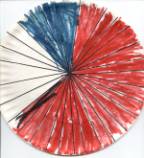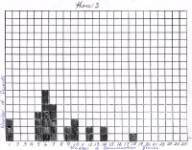
Phase 3: Sharing Results, Findings, and Understandings

Painting the mural depicting communication in our classroom.
Communication is a broad, abstract topic for K/1 students to study. Teachers were interested in children developing basic skills and knowledge in the content areas and in students’ gaining an understanding of the “big ideas” about communication.
Students learned that communication is an interchange of ideas. They came to appreciate the importance of good communicating. They gained an awareness of the relationship between communication and the means of sending and receiving messages. They were exposed to many experts in fields of telecommunication, physics, computer science, music, foreign language, audiology, speech and hearing, and sports.
When they began Phase 3, they brainstormed what they had learned (Student Communication Topic Web II). They were pleased with their responses:
| SL: Communication is so amazing. SJ: I never knew there was such a word “communication.” HB: When you talk it’s called communication. BG: Communication has so many parts. NC: Communication is important to the world. |
The children reiterated four major concepts that they had learned.
- Communication helps people solve problems.
- Communication can be many languages.
- Talking to each other is important for sharing opinions and explaining how you feel.
- There are many devices that help people communicate.
The children discussed what they would do to tell the story of how and what they learned about communication. They decided to create a model of a computer, a stand up display of face-to-face talking, a fabric mural of “communication in our school” and plays where people shared different modes of communication. They also wrote stories, poems, and a song.
Products
Model of a Computer
Children felt that computers were an important means of sending and receiving messages. They counted, did observational drawings, revisited their drawings, interviewed the computer programmer and decided to represent the computer with boxes and junk. They worked collaboratively on the model. The series of pictures shows their progress over several weeks.
 |
 |
|
|
CO begins the computer representation
with boxes.
|
The group made a list of what
they needed to complete their model.
|

Finished model of the computer.
Face-to-face Display
Children thought that communicating face-to-face was important for explaining how your feel, sharing opinions, and solving problems. A group wanted to display the face-to-face communication taking place in the classroom. They took pictures with a Polaroid camera of people communicating. Then they cut out drawings and displayed them for the Open House.

Representation of face-to-face talking in pictures and
in drawings
Mural: “Communication in Our School”
As the project developed, children began to realize that communication was an interchange of thoughts and opinions, not just the devices. A group decided to make a mural depicting communication in our school. Teams of children did observational drawings of people talking on the telephone, people talking, people writing words and sending them by email and mail. The children revisited their drawings. The team made a plan by grouping their drawings the way they wanted them to appear on the mural. The drawings were then photocopied, cut and arranged on an overhead projector according to the plan. Using the overhead projector, children transferred the drawings to a fabric mural attached to the wall. Then they painted the mural with acrylic paints.
Play - “Communication in the Future”
In Phase 3, the children engaged in some imaginative activities related
to communication. Children predicted what communication would be like
in the future.
They dictated their predictions, illustrated with watercolors, and categorized
their ideas into five groups:
- In the future, families would still be talking and listening to each other.
- In the future, people will still get angry, not communicate and have fights and wars.
- In the future, there would still be people who didn’t communicate and get into trouble.
- In the future, there might be health problems with the communication devices.
- In the future, communication and tolerance for other languages will be important in space.
They wrote original plays to dramatize their predictions. (Three children chose not to be in a play but helped with the scenery). The teacher acted as facilitator by scribing and asking probing questions.
During Project/ Activity Time, the students practiced their lines, made costumes and designed the scenery. The children learned about the sound level of their voice, diction and staging. Their parents, families and friends enjoyed these original productions.
 |
 |
|
|
Judge and lawyer in a courtroom
scene.
|
"In the future there will
still be basketball players getting angry."
|
Riddles, Poems, Songs, Stories
Children explored many different genres of writing that related to communication. These included riddles, poems, songs and stories. They wrote “What Am I” riddles to incorporate what they had learned throughout their investigation. This is one example of a riddle about the child’s trip to the post office.
 |
||||
|
What am I?
I have letters. I am not an envelope. |
What am I?
I have machines. I am not a factory. |
What am I?
I have security cameras. I am not a police station. |
||
I am a post office.
The teachers read a number of poems to the children in whole group meetings where communicating was the theme. The teacher explained elements of poetry such as metaphor, simile, and personification. The children tried their own metaphors, similes and personifications during language and literacy small group instructional time. Their examples were displayed around the room for sharing day.
|
Communication Metaphors Computer is my way of doing things when people I know are gone
- JB Personifying Communication Devices Cell phones can see you. They can hear you - SL |
The children wanted to share their newly acquired sign language ability. They chose to sign the Alphabet song, “Twinkle, Twinkle” and some parts of the “Communication Song.”
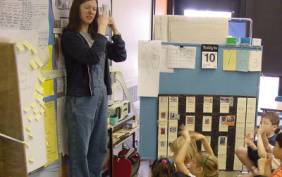
Children practicing sign language
Tune of “Sing, Sing a Song”
Communication is sending messages, sending messages to someone. (Repeat)
Sound travels through sound waves. Sound waves are invisible. (Repeat)
We use many ways, many ways to communicate. (Repeat)
We communicate face-to-face and we use our voices. (Repeat)Like we use phone e-mail, signs and different languages. (Repeat)
We also use codes, satellites, T.V. flight and letters. (Repeat)
Babies learn to communicate and so do animals. (Repeat)
We found out through experiments, books, experts and field trips. (Repeat)
Good communication is important.
The teachers read a variety of versions related to the story of the “Emperor’s New Clothes” and “Chicken Licken” or “Chicken Little.” Children compared and contrasted the characters, illustrations, sequence of plot, differences, moral/lesson and communication/miscommunications in the stories. They displayed an “Emperor’s New Clothes Comparison Chart” for the parents. After reading and comparing “Chicken Licken” stories, They edited and published “Chicken Licken” stories.
Chicken Licken
by Nicholas
Once there was a chicken named Henny Penny. When she walked through the
forest an acorn fell on Henny Penny ‘s head. She looked up it was
an oak tree. She looked on the ground it was an acorn. She thinks that
the sky was falling so she runs as fast as fast as she could. Then she
met Cockey Lockey. Henny Penny told her that the sky was falling. Cockey
Lockey did not believe her but an acorn fell on Cockey Lockey’s head.
She told Henny Penny she was right the sky was falling. So they ran as
fast as they could. Then they met Goosey Loosey. They told Goosey Loosey
that that the sky was falling. Goosey Loosey did not believe them but
another acorn fell on Goosey Loosey’s head. She told them that the
sky was falling so Goosey Loosey had an idea. She said that they should
tell the police. They said that is a good idea so they walked out of the
forest. Then they found Ducky Lucky. They said the sky was falling so
they said they were going to tell the police. Ducky Lucky did not believe
them but an acorn fell on Ducky Lucky’s head. She told them we should
tell the police so they walked and found Chicken Licken. She told her
the sky was falling we are going to tell the police. So they found Turkey
Lurkey at the edge of the forest. Henny Penny got hit on the head we are
going to tell the police. Let me have a look on Henny Penny’s head.
Then she found a way to help. She put a sheet of cloth on Henny Penny’s
head then they found an acorn fell on Henny Penny’s head. It did
not hit head they yelled hooray so they went on. Then they met the greedy
Foxy Loxy. She looked on a tree. It said wanted Foxy Loxy go to the police
quickly she told her friends to see that poster they ran out of the forest.
Then Henny Penny had an idea we should attack Foxy Loxy first before going
to the police but Turkey Lurkey asked where should we go? I think we are
lost. So they followed their tracks but when they got there Foxy Loxy
was gone. Then they found some of Foxy Loxy 's tracks so they were detectives
so they looked and looked then they found Foxy Loxy. They grabbed him
and they took him to the police. They are going to watch out Foxy Loxy.
The end.
The True Foxy Loxy
by Jaya
A cat who was an orphan, named Stripes, was walking under an oak tree. An acorn fell on Stripes. Stripes went to tell the king a robber hit her. On the way to tell the king, she met Foxy Loxy, but she already had known about Foxy Loxy because his children were friends with Stripes. They had played several times. Stripes had to stay over for the night, because she had stayed at Foxy Loxy's house too long. Soon Stripes became part of Foxy Loxy's family.
The End
Display
Teachers and children listed displays that they wanted to share with parents. They chose to display their drawings of chapters from The Little Prince, their graphic representations of data from the parent survey, and their newly acquired communication vocabulary.

Illustrated chapters from The Little Prince
Children drafted a survey for parents asking them:
- When you were young, did you have all the communication devices that we have now? (Please circle all that apply) TV-color, black & white; Cameras-color, black & white, video, digital; Phones-what did it look like (draw, please), cell phone; Radio-all channels; Computers-lap-tops, e-mail, printer-color, black & white (See Overview).
- When you were little (5-7 years old), how many languages did you know? Foreign language, sign language, flag language, codes.
- How many communication means do you use in your house? (List them, please)
- Did you learn anything from us about communication?
These are some examples of how the children displayed the results of their parent survey.
| Data display for question #2. More parents responded that they knew a foreign language better than any other language when they were young. |
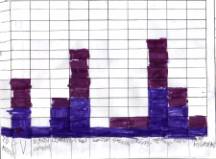 |
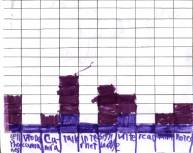 |
|
|
Data display for question #3. The
most popular means of communication in the parents' homes were telephones
and email.
|
||
| Data display for question #4. 19 parents responded (red) that they learned from the children about communication. The blue indicates the number of parents who said they did not learn anything about communication from their children or left it blank. The white indicates the number of surveys not returned. |
After sharing all of these displays, some students decided to represent their findings for question #3 another way. They were interested in how many communication devices were used by each of the parents. They counted how many devices the parents listed on their surveys. They graphed the number of devices that parents reported.
| This graph showed that 7 parents reported using 6 communication devices in their homes. One parent reported using 18 communication devices in his/her home! |
Children wanted to make a list of all the new words and their definitions to share with their parents. They became more skillful at integrating new vocabulary words into their conversations about communication.
|
Share Day
Children performed the plays that they had practiced many times. They sang their songs and then positioned themselves around the room giving speeches to the parents about the displays. Everyone enjoyed the sharing.

Space
Alien - Matthew
Robot, Crystal Queen - Natalie
Robot - Liam
Family In The Park
Mother - Hannah
Kids: Anne - Jaya
Jane - Jade
Christy - Karishma
Court
Judge, Mr. Cornelius - Cornelia
Lawyer - Mr. Jared
Person getting talked to - Shivani
Hospital
Dr. - Amanda
Dr. - Blas
Soccer
Basketball Referee - Jessie
Soccer Referee - Amrutha
Narrator - Sunden
Soccer Player - Kevin
Soccer Player - Chris M.
Nintendo Player - Wiley
Nintendo Player - JJ
Basketball Player - Nicholas
Basketball player arguing - Chris S.
Songs: ABC, Twinkle Twinkle Little Star, Communication song
Ushers: Jordan, Erica, Evelyn
Producers: Marjorie, Christy, Yore
Friday, May 18
1:45
|
|
 |
||
|
STUDYING
CONSTRUCTION |
EXPLORING
COMMUNICATION |
© 2001. University
Primary School. Department of
Special Education. University of Illinois.
All rights reserved. Credits.




